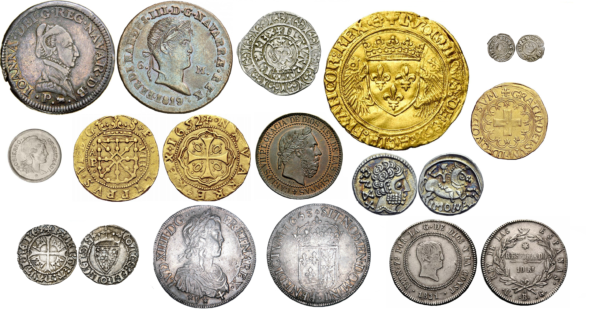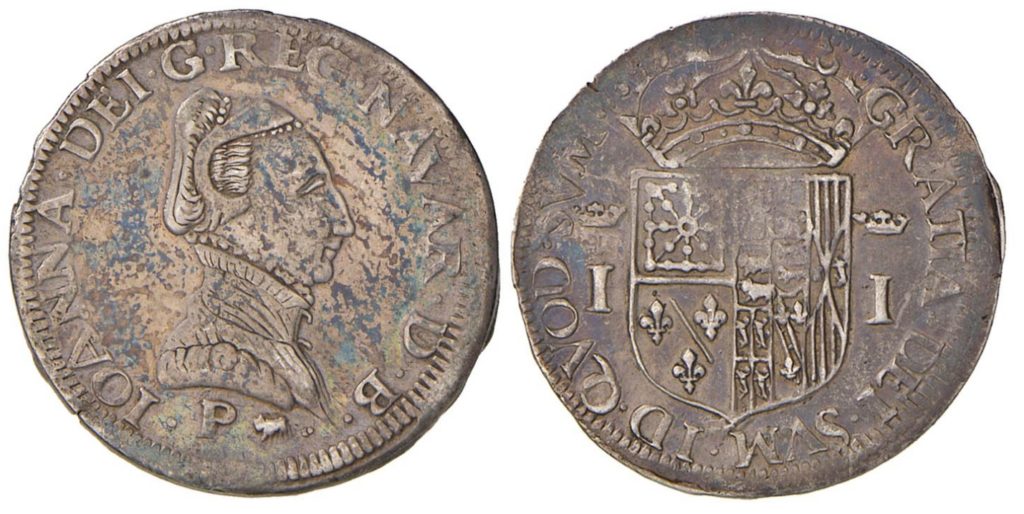Victory: Joan III, Queen of Navarre, Joan I, Lady of Béarn
Type: Teston
Year: 1566
Mint: Mint of Pau
Border: Irregular
Edge Engraving: ————–
Metal: Silver (about 898 thousandths,)
Diameter: 28 mm
Weight: 9.41 grams
Quantity: Between 1564 and 1566, 292,320 testons and half testons
Coinage: Flywheel by press, silver by mill laminated
Mintmaster: Étienne Bergeron (The Symbol of the Moon and the Star)
Recorder: Guillaume Martin, assistant to Pierre Brucher
Front:
Front Words: IOANNA. CALL G. REG. NAVAR. DB P
Obverse Description: Bust of Joan III facing right, wearing a pearl-embellished robe. The details of the collar of the robe are noteworthy. The letter P represents the mint of Pau and the small cow represents the Lordship of Béarn.
Frontispiece: Joan, by the grace of God Queen of Navarre, Lady of Béarn (DB DOMINA BEARNI).
Back:
Back Words: GRATIA (flower) DEI. SVM. ID. QVOD. SVM. 1566 Moon under a star.
Reverse Description: A crowned coat of arms between two crowned letters I, showing the family's origins and territories. The coat of arms shows the lineage of the Navarre, Bourbon, Bearn, Rodez-Armagnac, Albret, Évreux, Bigorre, and Trastamara families. Year of engraving 1566, Moon and star symbol of Étienne Bergeron.
Background Translation: By the grace of God, I am what I am. The traditional image text on Navarrese coins, begun by Henry II, and used by his successors until 1652.
Today we will continue the section on Joanna III and if we talk about Joanna, we could go on for a long time, as she was a queen who had a fundamental importance in the history of Navarre, the Basque language and the north. We will have to provide a long historical context in another section, but if we wanted to summarize the meaning of Joanna's life for me in two words:
I would say that she was the only reigning queen of Navarre and the queen who ordered the translation of the New Testament into Basque.
A brave, combative, hardworking woman, and true to her principles, she died of tuberculosis in Paris in 1572, while her son Henry III was preparing to marry Princess Margaret of Valois. After the death of her father, Henry II of Navarre in 1555, she became the heiress of Navarre, although she had to remain under the tutelage of her husband, Anthony of Bourbon, until his death in 1562.
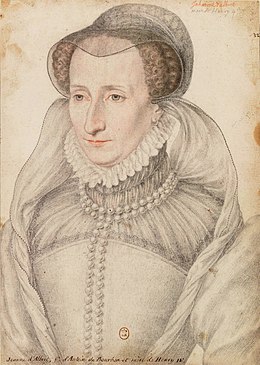
Portrait of Queen Joan III of Navarre – around 1560 – School of Francois Clouet – Wikipedia
While we await the historical context section, in this section we will talk about Joan's coinage, or rather, the coins she created at the Pau mint. There is a story to tell here too.
The teston was a coin introduced into French territory by Louis XII of France by decree of April 6, 1514. A decree of his successor Francis I in 1540 confirmed its use, making it the first heavy silver coin to be introduced in France.
As we have said, the testone was a silver coin, worth ten seulements when it was created, and its peculiarity was that it had a portrait of the king on one side. Hence its name, since the Italian word “testone” means head. When it was created, its nominal weight was around 9.54 grams, and along with the whole testones, half testones were also minted, with half the nominal weight.
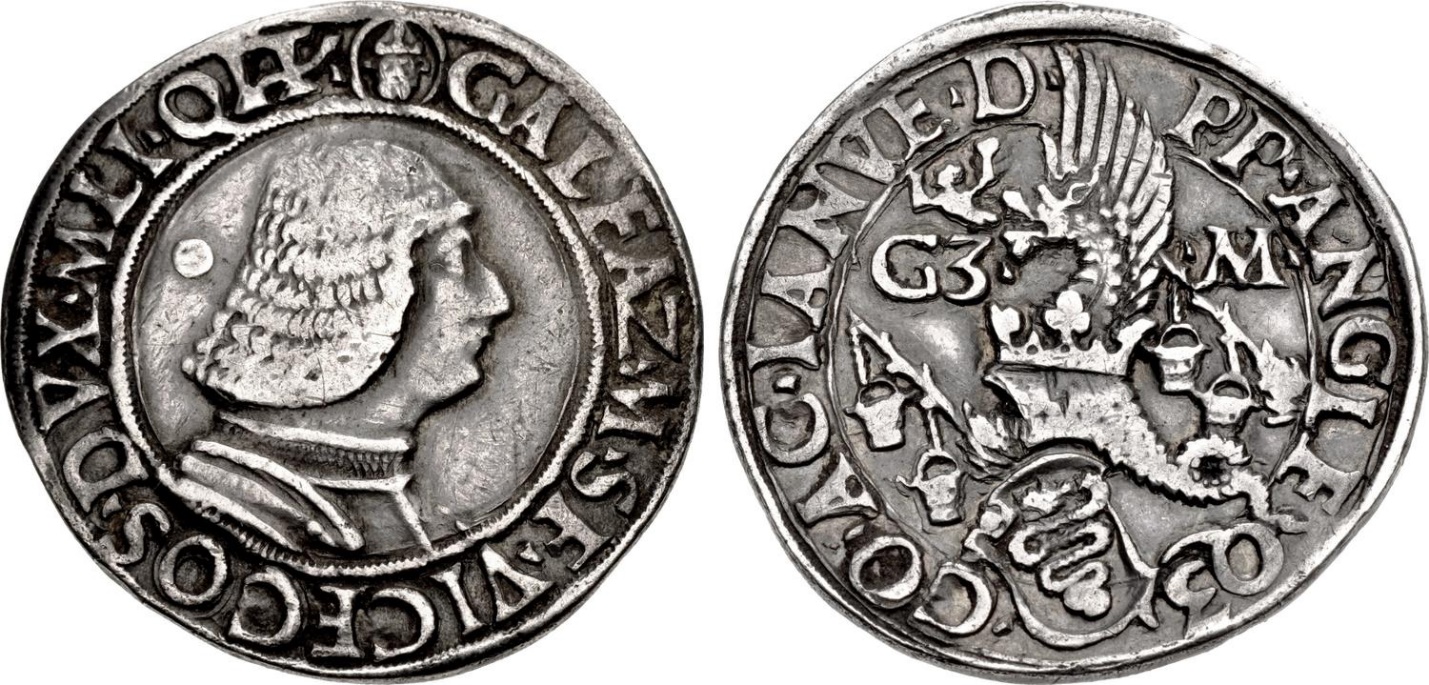
Headstone of Galeazzo Maria Sforza, Duke of Milan (1466-1476) – 28mm, 9.57 gr
The first coins were minted in 1450 in the Duchy of Milan, which was under the rule of the Sforza family. The Sforzas decided to depict the sovereign's portrait on their coins, following the custom of the ancient Romans. Louis XII, after becoming Duke of Milan in 1504, decided to incorporate the new coinage into the French monetary system.
In addition to the two French kings mentioned above, testons were minted during the reigns of Henry II, Francis II, Charles IX and Henry III. The latter discontinued the manufacture of testons in 1577 and replaced them with quarter-euro, eighth-euro, and silver franc and half-franc coins. During the reign of Louis XIII, the use of testons was prohibited in 1641 and they were subsequently withdrawn.
The first teston specimens that I have found in the Bayonne mint date back to 1554, already under the reign of Henry II of France (1547-1559). A year earlier, in 1553, it seems that half testons had begun to be produced in Bayonne. However, the testons made in Bayonne were made by hammering and not by a flywheel press like the testons made in Pau.
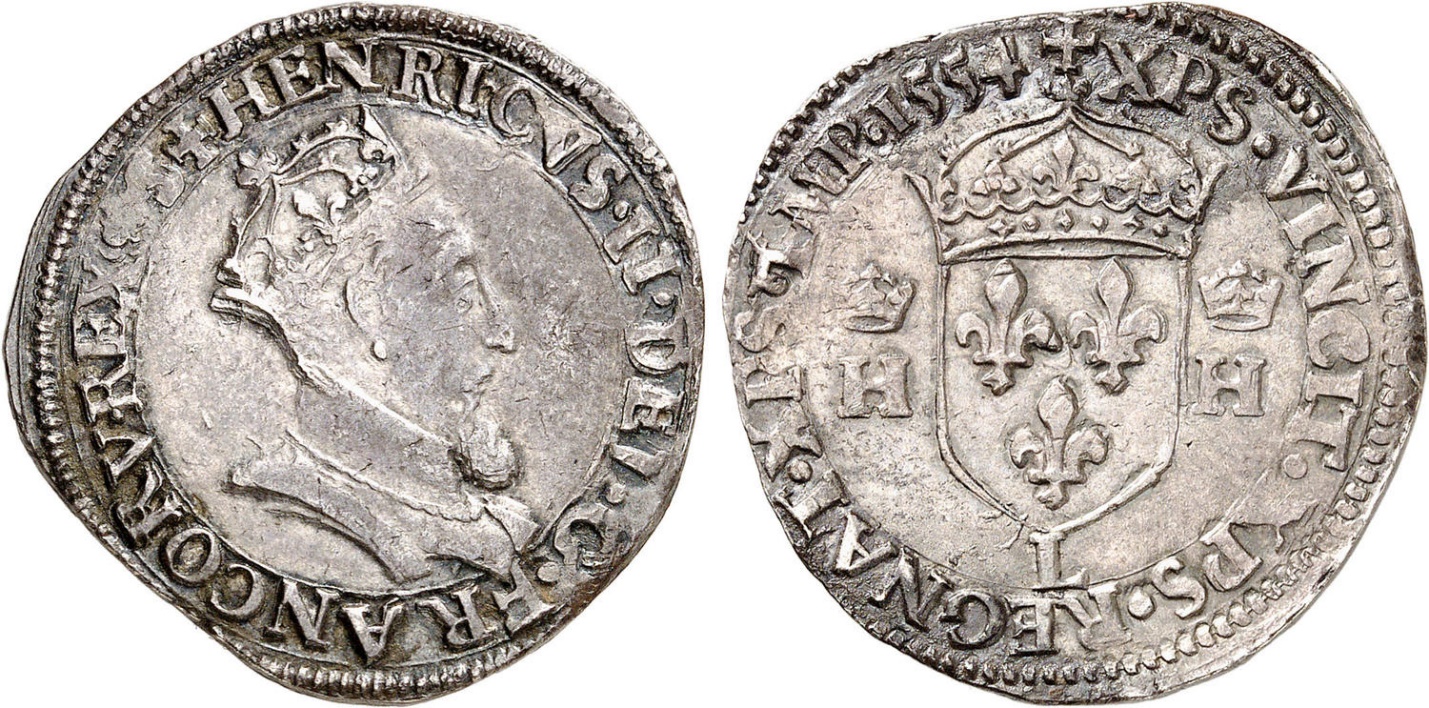
Bayonne mint coin of Henry II, King of France – 1554 – 29.5 mm, 9.41 gr
The first coins minted in the Kingdom of Navarre, north of the Pyrenees, were the proofs minted in Pau in 1555. As we saw in the previous section (link), the first proof coins struck at the Pau mint were struck by a flywheel press under the direction of the mintmaster Jean Erondelle. These proof coins are found in limited numbers today, they all bear the date 1555 and unfortunately we have not been able to find much detail about them in contemporary documents. The following video by David Navarre shows the hand-held appearance of a 1555 proof coin from his collection (link)
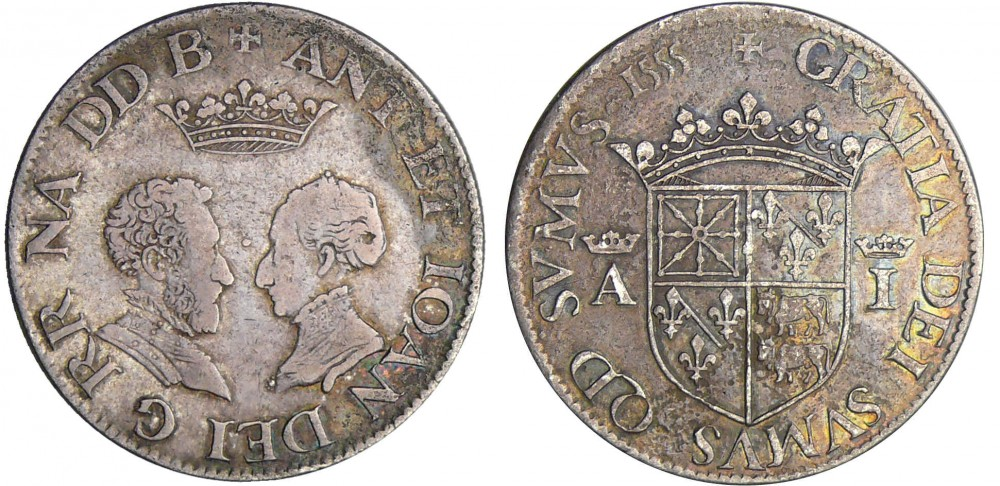
Proof of 1555 minted at Pau mint under the command of Jean Erondell – 27mm, 9.22gr
+ ANT ET IOAN DEI G RR NA DDB – + GRATIA DEI SVMVS QD SVMVS
The coins of the Kingdom of Navarre, during the reigns of Kings Antonio and Joanna, and their son Henry III, were struck until 1577, always at the mints of Pau or Morlaas, as the Navarrese mint of Donapaleu was not reopened until 1579. While they were struck by a flywheel press at the Pau mint, they were struck by hammer at the Morlaas mint.
The fact that the minting of testons began so late in the mints of Bayonne and Bearn-Navarre gives us clear evidence of the trade and sources of silver at the time. At the end of the 15th century and the beginning of the 16th century, new silver mines discovered in the European Alps made it possible to mint large silver coins like testons. However, this minting began in the areas surrounding the source of silver, namely eastern France, northern Italy and the area of present-day Austria-Germany. These areas were also located on the trade axis that crossed the European continent from north to south.
However, the discovery of the huge silver mines in the Indies gave the kingdom of Castile control of the silver supply. Taking advantage of the new wealth, a new and important trade axis was created, structured around the constant thirst for products and services of the Spanish kingdoms. Around this new trade axis, the mints of Bayonne and Béarn-Navarre were perfectly located. And indeed, these mints remained strong until the Spanish monarchy lost its territories in the Americas.
Hammered testons began to be produced at the Morlaas mint from 1560 onwards. The Morlaas testons followed the model of Jean Erondell shown earlier and we will discuss them in the section on the Morlaas coins of Joan III.
The first Pau model, under the direction of Etienne Bergeron, Guillaume Martin and Pierre Brucher, was produced between 1564 and 1570. From then on, until Joan's death, in 1571 and 1572, the models following a second model were produced under the direction of Etienne Bergeron, Jerome Lenormant and Pierre Brucher.
In this case, and in contrast to the testons of 1555, documents preserved to this day in the archives of the department of Basses-Pyrénées have come down to us, the numbers of coins minted in the mints of Bearn and Navarre. These mint accounts show the numbers of different coins minted in the mints of Pau, Morlaas and Donapaleu from 1562 onwards. Thanks to these accounts, we know to a large extent how many testons were minted in the Pau mills under the reign of Joan III. These accounts were summarized by Francois Dumas in a work published in 1959 (see bibliography).
|
Year |
Coin Weight (Marks) |
Number of coins (units, including half-tests) |
Half-texts |
Comments |
|
1564 |
11.600 (1564-1566) |
292.320 (1564-1566) |
Yes |
First Model |
|
1565 |
– |
First Model |
||
|
1566 |
Yes |
First Model |
||
|
1567 |
No data |
No data but there are specimens found |
– |
First Model |
|
1568 |
8.309 |
211.796 |
– |
First Model |
|
1569 |
3.426 |
87.188 |
– |
First Model |
|
1570 |
2.399 |
61.174 |
– |
First Model |
|
1571 |
2.587 |
65.968 |
– |
The emergence of the second Testoin model |
|
1572 |
1.411 |
35.980 |
– |
Second Model |
Summary of the Testoni coins minted at the Pau mill between 1564 and 1572
When presenting the weight of general coinage, the accounts use the Paris mark as the unit of weight. One Paris pound weighed 489.5 grams, and therefore one Paris mark was equivalent to 244.75 grams. If we examine the numbers in the table above, we can conclude that the testons had an average weight of 9.60 grams. Adrien Blanchet, in his book “Histoire Monetaire du Bearn”, states that the testons were minted in 25 and a half pieces per mark unit, which would again give us an average weight of around 9.60 grams. Similarly, the half testons should have an average weight of 4.80 grams.
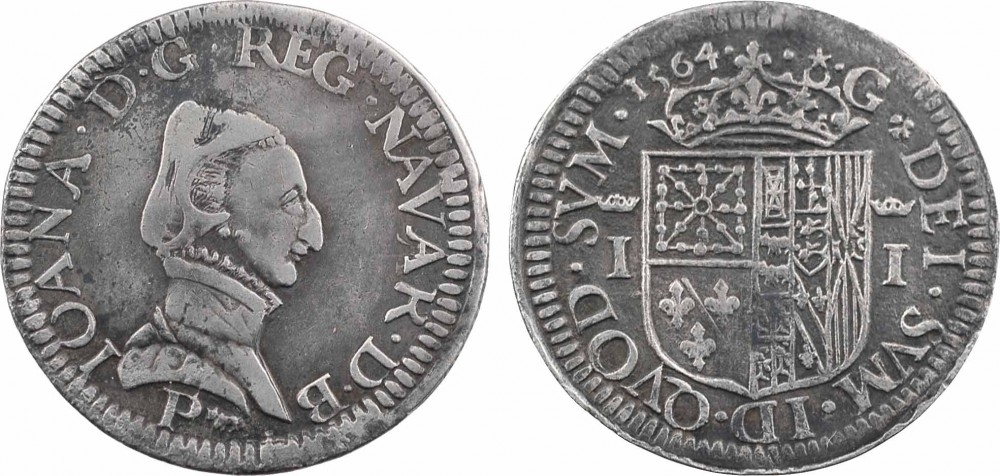
Half teston minted at Pau under the rule of Etienne Bergeron – 25mm, 4.53gr – 1564 – Fluted edge
+ JOHN DG REG. NAVAR. D. B (Cow) P- + G (Flower) CALL. SVM. id. QVOD. SVM. 1564
Regarding legality, we know that testons began to be minted at a value of 10 dinars and 18 t'3/4 granas, that is, 898 thousandths, but between 1568 and 1572 they had already been reduced to a value of 10 dinars and 17 t'1/2 granas, that is, 894 thousandths.
Until 1561, the face-to-face testimonies of Joan and Anthony of 1555 were worth between 11 shillings and 6 dirhams and 11 shillings and 10 dirhams in France. From this year onwards, the value of these testimonies and their successors was 12 shillings throughout the reign of Joan III.
As mentioned earlier, we can find two teston models at the Pau mint during Joan's reign.
The first model, which appears at the beginning of this entry, was produced at the Pau mint between 1564 and 1570. The engraver was Guillaume Martin. Among the examples of the first teston model, there are also those with a fluted edge (although these tend to be rarer). As with the flywheel press, the production of edges was an important innovation, since the technology of the time did not allow for their easy production. This innovation was created by Aubin Olivier at the Moulin des Etuves, but it was usually only used for the production of medals and coins of prestige or gift. However, at the Pau mill mint, it was applied to the production of general coins for a short time. The testons with a fluted edge seem to have been produced between 1564 and 1567. However, as mentioned, not all the testons produced during these years have this type of edge. As a reference, it was only in the 1680s that edge processing began to spread in the Kingdom of France, using the Castaing machine.

Another example of the first test coin from the Pau mill mint of Joan III, 1565 – 9.36 gr
Etienne Bergeron – Head of the Mint; Guillaume Martin – engraver; Pierre Brucher – assistant engraver
JOHN CALL G. REG. NAVARRE DB (Cow) P – GRTIA (Flower) CALL. SVM. id. QVOD. SVM. 1565
The second model can be found in 1571 and 1572 and shows a new portrait of Joan created by the engraver Jerome Lenormant (or Lenormand). Compared to the previous portrait, Joan still wears a headdress, but presents more complex and elaborate clothing and wears jewelry over her dress, like a figure appropriate to the court. This second portrait conveys the steadfast gaze of the mature queen, who is over forty years old.
These coins, belonging to the second model, show the B letter or DB monogram on the crown of Navarre instead of the crescent and star. Some coins also show an acorn on the obverse, to the right of Joan's name. These are probably again the hallmarks of the mintmasters and engravers (B-Bergeron, Acorn – Lenormand).
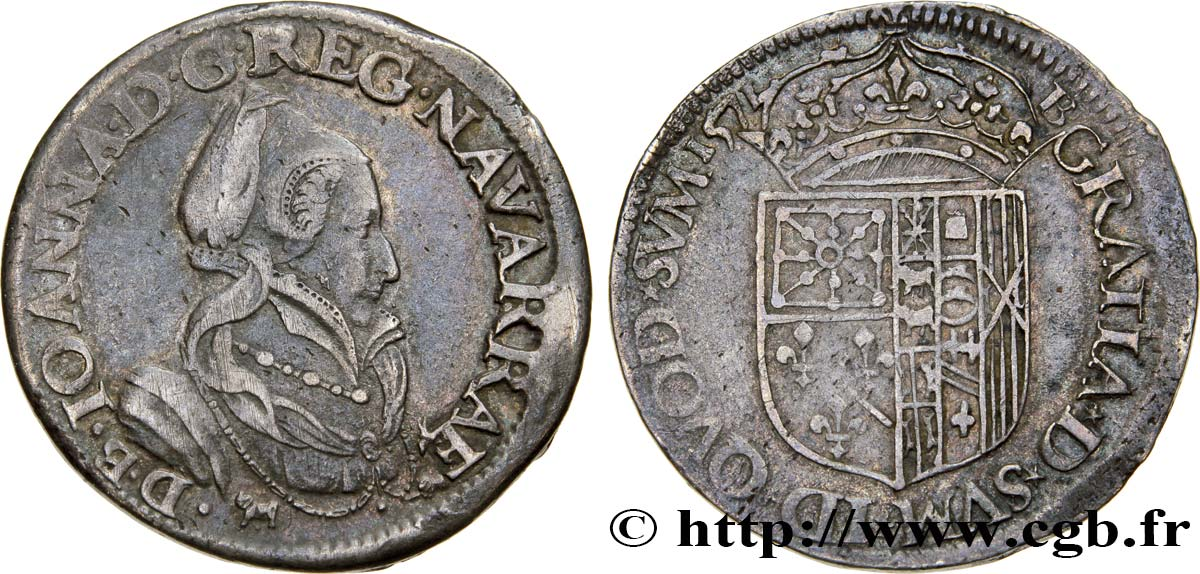
A specimen of the second teston model from the Pau mill mint of Joan III, 1571 – 9.60 gr, 27.5 mm – cgb enkatechea
Etienne Bergeron – Head of the Mint; Jerome Lenormant – engraver; Pierre Brucher – assistant engraver
DB IOANNA DG REG. NAVARRAE (Beef) – GRATIA. D. SVM. id. QVOD. SVM. 1571
As we can see in the images of the coins that have already appeared, the pictorial texts of these coins show numerous variants, such as IOANA, IOANNA, NAVARE, NAVAR, NAVR, NAVARRE, NAVARRAE, NAVRE, GRTIA, GRATIA + D . SVM etc. Surely, since the new flywheel presses broke many dies and new ones had to be made frequently, numerous variants were created.
From mid-1568, religious unrest spread to the territories of Bearn and Lower Navarre, and Joan was forced to flee to La Rochelle. War broke out and Joan was unable to return to her territories until 1571. These turbulent times can also be seen in the coins we collect today, as the coins of 1569 and 1570 are the rarest, along with those of 1572.
These turbulent times brought about an interesting evolution in the testimonies of recent years. To understand this evolution, we need to look at a couple of elements: on the obverse, the size and shape of the image of the Béarn cow and the appearance of the acorn, and on the reverse, the disappearance of the crescent and star and the appearance of the B or BD monogram.

A rare 1570 specimen of the first test coin from the Pau mill mint of Joan III –9.47 grs – 27 mm
Etienne Bergeron – Mintmaster (DB Monogram on the obverse); No clear engraver's mark is visible anywhere
JOHN DG REG. NAVAR. DB (Cow) P – GRATIA (Flower) D. SVM. id. QVOD. SVM. 1570 BD Monogram
BD Monogram instead of star and moon and larger size of the Cow and simpler workmanship
Olivier Goujon Numismatique, Live Auction 4 Lot 166 24.02.2022
The next transformation shows us the transition to the second teston model. On the obverse, the year 1570 appears, probably a reflection of the year in which the image was developed, as well as the acorn symbol of the engraver Jerome Lenormant. On the obverse, the year the coin was minted 1571 and the monogram BD, perhaps associated with the mintmaster Etienne Bergeron. These very rare specimens showing two years do not have any trace of crowned I on the obverse.
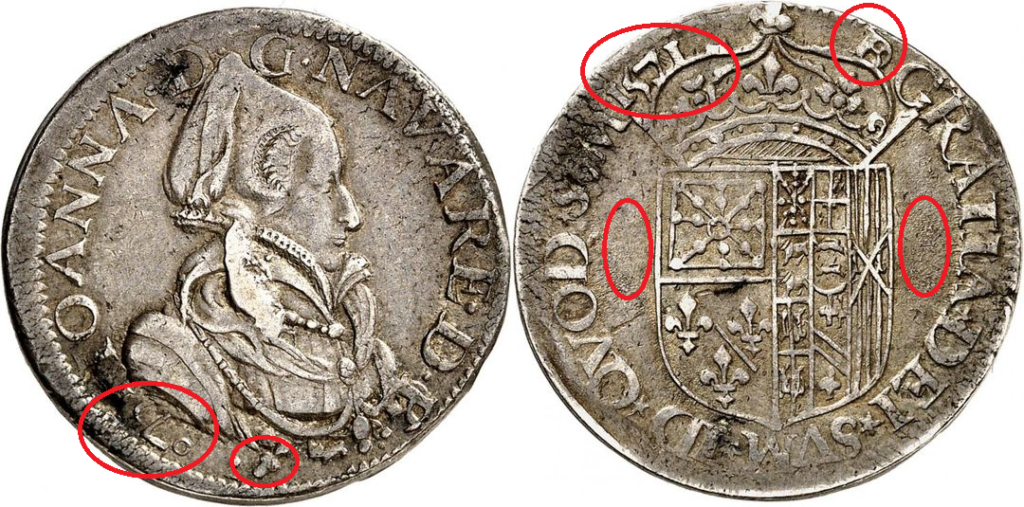
Second teston model specimen from the Pau mill mint of Joan III, 1570-1571 – 9.67 gr;
Found: 1570 IOANNA.DGNAVARRE.DB (Cow) (Acorn) Acorn – Jerome Lenormant
Obverse: (BD) GRATIA*DEI*SVM*ID*QVOD*SVM 1571 – BD attributed to the mintmaster Etienne Bergeron
Burgan Numismatique May 2018 Auction Lot 61 25.05.2018
Because even in the coins of these second models, the appearance of these crowned I izki is the most normal, although in the two coins so far we have been able to see an exception to this. Let's look at an coin from 1571 and another rare coin from 1572:
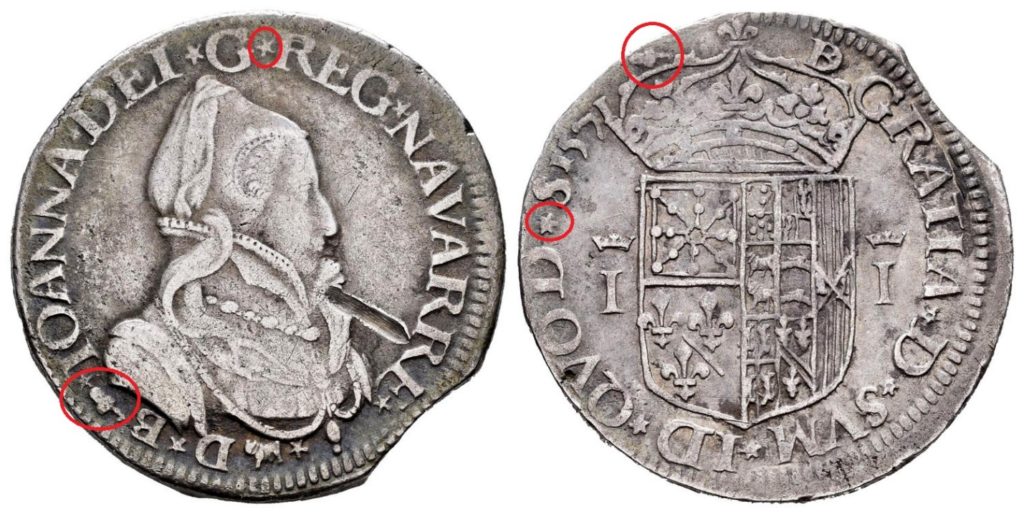
Title:IOANNA*DEI*G*REG*NAVARRE* *(Cow)D*B (Acorn)* Engraver Jerond Le Normand
Obverse: (BD) GRATIA*D*SVM*ID*QVOD*S 1571 (Acorn) Attributed to Jerond Le Normand – Etienne Bergeron, mintmaster
Words separated by asterisks
TAULER & FAU AUCTIONS, AUCTION 49, LOS 2813 14.01.2020
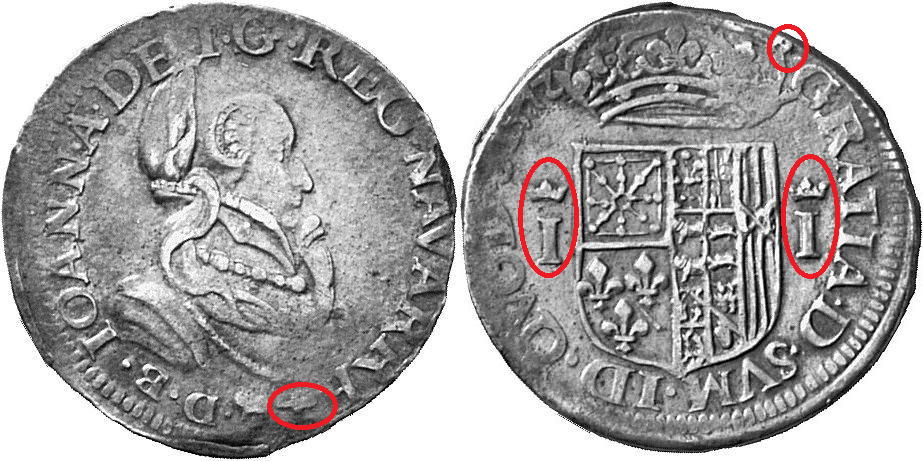
Second mintmark of Joan III's Pau mill, 1572 – 9.61 gr
Search:IOANNA.DEI.G.REG.NAVARRE. (Acorn) (Cow) DB Acorn – Jerome Lenormant
Obverse: (BD) GRATIA.D.SVM.ID.QVOD.S 1572 – Attributed to the mintmaster Etienne Bergeron
Münzen und Medaillen AG Basel Auktion 87 Lot 449 04.06.1998
As we have seen, there have been numerous variations in recent years; around the crowned I, around the mintmark and engraver's marks, around the image text and years, around the dots or stars separating words... the number of variations on Joan's testa is absolutely rich.
Finally, a few words about the coat of arms of the Queen of Navarre, which appears on the back of the coins. In some books on Navarrese-Bearn coinage, it is described as the coat of arms of nine subdivisions. In fact, Joanna's testa show a collection of eight subdivision coats of arms, since it was her son Henry III who created the collection of nine sub-coats in the Pau testa. Joanna's coat of arms seems to lack the coat of arms of the county of Foix. Consequently, Joanna's testa show the coats of arms of Navarre, Bourbon, Albret, Bearn, Bigorre, Armagnac-Rodez, Evreux and the Trastámara. However, the coat of arms of the Trastámara should have four vertical bars and instead only shows three, similar to the coat of arms of Foix. It is also necessary to remember that in the Middle Ages coats of arms did not have a national territorial significance, but were a reflection of the family's origin and ancestral characteristics.
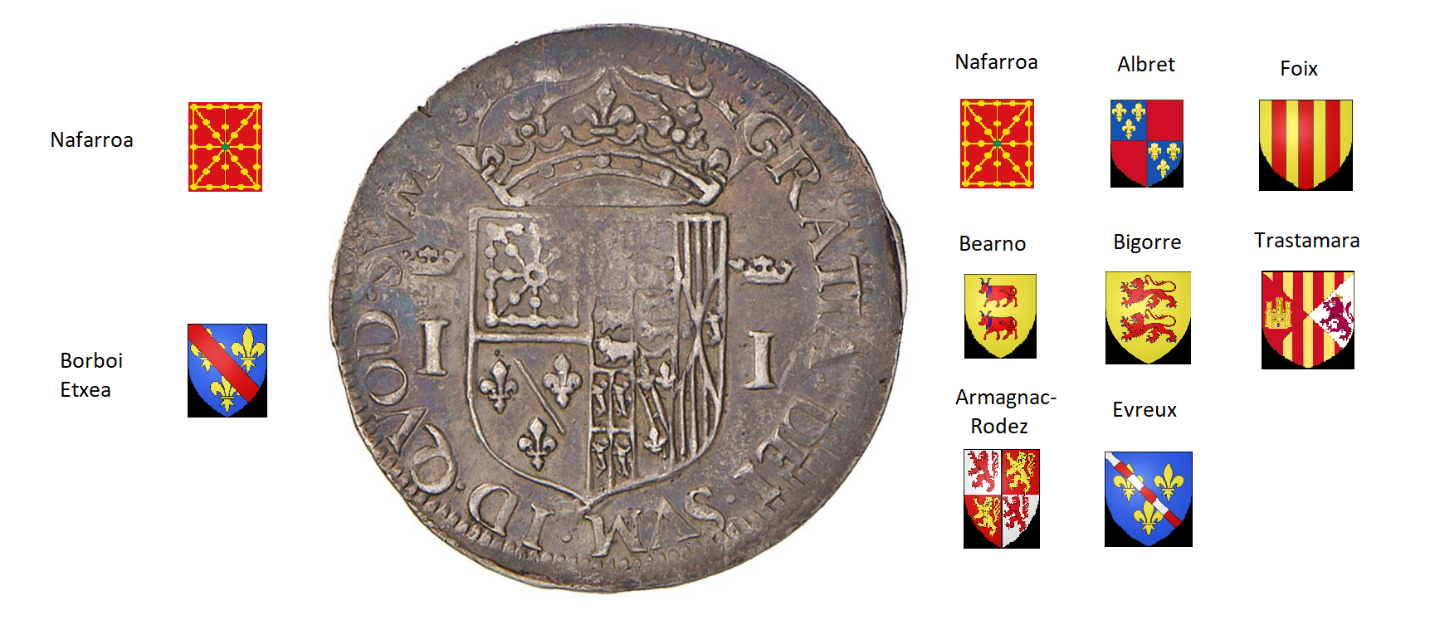
Explanation of the different coats of arms on the back of Joan's coat of arms
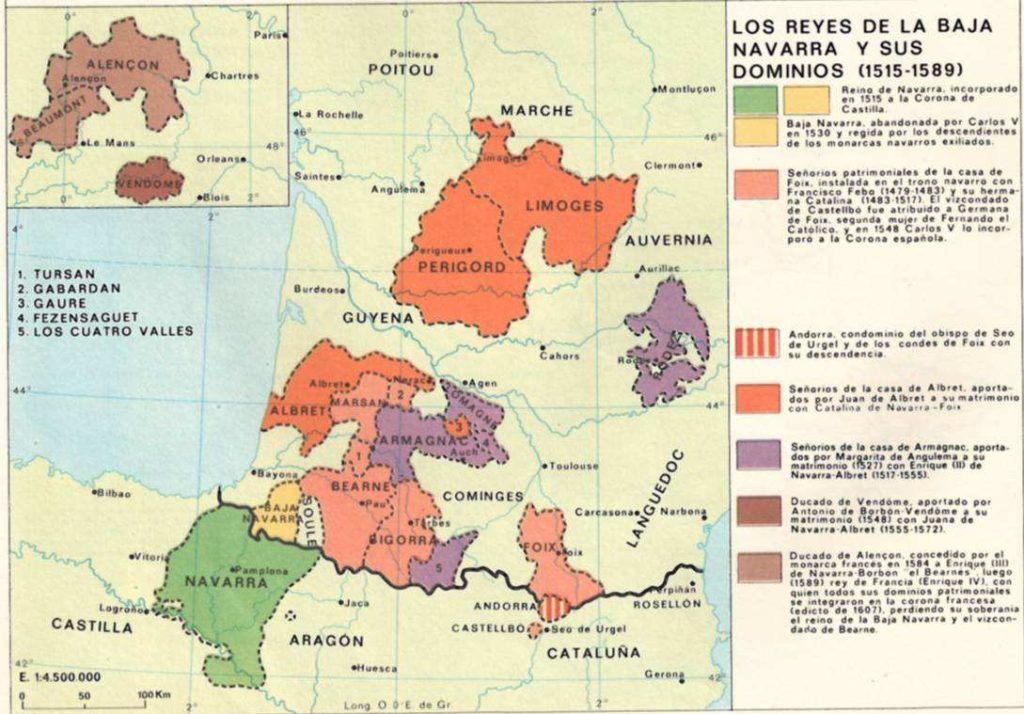
The territories of the royal house of Navarre – Labrit-Foix-Bourbon – Béarn and Lower Navarre were sovereign states, and were not feudal territories of the French crown.
The territories they should have had in the kingdoms of Castile and Aragon are not listed, only the Viscounty of Castellbo.
Lower Navarre and Bearn were not incorporated into the Kingdom of France in 1607, but in 1620, during the reign of King Louis XIII.
I have said the coat of arms of the Trastamaras but surely, to be completely precise, I should say the coat of arms of John, Infante of Aragon and Duke of Peñafiel. John the Infante, later John II of Aragon and Navarre, was the father of the Prince of Viana and Fernando the Catholic. When he married Queen Blanca of Navarre in 1420, he added his duchies of Montblanc and Peñafiel to the couple's treasury. In addition to these, after becoming King of Aragon, he gave the duchies of Gandia to his and Blanca's son, the Prince of Viana.
In fairness, these three duchies, as well as the Viscounty of Castellbo and the town of Balaguer, were the property of Queen Leonor of Navarre, daughter of John and Blanca, and her heirs. But the kings of Castile, first and then Ferdinand the Catholic, who became king of Aragon in 1479, abandoned the rights of the kings of Foix and Labritja to these properties. In any case, both Leonor and all her heirs were named Duchess or Duke of Gandia, Montblanc and Peñafiel. As a result, as a witness to the succession of John Trastamara, his coat of arms appears on the coins of the kings of Navarre.
This coat of arms should therefore not be taken as the united coat of arms of Aragon, Castile and León, but rather as a declaration of the succession granted by John II. This is a mistake that all auction houses and coin books repeat.
TESTON MONNAIE – Wikipedia – link
FRAPPE AU BALANCIER – Wikipedia – link
Numismatique, la frappe au balancier– Youtube Video – link
THE COIN IN NAVARRA – NAVARRA MUSEUM – EXPOSITION FROM MAY 31 TO NOV 25 2001. Miguel Ibáñez Artica link
MINT OF NAVARRE AND BEARN – WIKIPEDIA – link
Histoire monétaire du Béarn – Jules Adrien Blanchet – 1893 – link
MONNAIES DE FRANCE, DE NAVARRE ET DU BÈARN – Jean Claude Ungar – 2010
Les frappes monétaires en Béarn et Basse-Navarre d'après les comptes conservées aux Archives départementales des Basses Pyrénées - Françoise Dumas - 1959 - link
LES MONNAIES FRANCAISES ROYALES – Tome 1 et 2 – 2° Edition -1999 -Jean Duplessy (In Memoriam 1929- 2020)
Le livre des monnaies feudales de Béarn et de Navarre – Jeanne d'Albret (seule) 1562-1572 – Club Numismatique Palois – Serge Salles – link
The book of feudal coins of Béarn and Navarre – Antoine de Bourbon and Jeanne d’Albret 1555-1562 – Club Numismatique Palois – Serge Salles – link
JUANA III de Albret -34° QUEEN OF NAVARRE (1555-1572) – Casa Real Navarre – link
JUAN II OF ARAGON – WIKIWAND – link
COLLECTION DAVID NAVARRE – Teston 1555 – Youtube Video – link
All personal data collected on this blog will only be used to disseminate the contents of this blog. Personal data will never be transferred or sold to third parties. You can unsubscribe at any time by clicking on the link in the footer of our emails.
